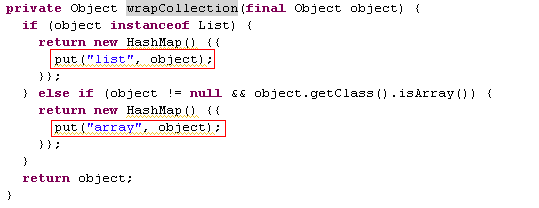转自:http://blog.csdn.net/wj3319/article/details/9025349
在SQL开发过程中,动态构建In集合条件查询是比较常见的用法,在Mybatis中提供了foreach功能,该功能比较强大,它允许你指定一个集合,声明集合项和索引变量,它们可以用在元素体内。它也允许你指定开放和关闭的字符串,在迭代之间放置分隔符。这个元素是很智能的,它不会偶然地附加多余的分隔符。下面是一个演示示例:
<select id="findByIdsMap" resultMap="BaseResultMap">
Select
<include refid="Base_Column_List" />
from jria where ID in
<foreach item="item" index="index" collection="list"
open="(" separator="," close=")">
#{item}
</foreach>
</select>
但由于官方文档对这块的使用,描述的比较简短,细节上也被忽略掉了(可能是开源项目文档一贯的问题吧),也使用不少同学在使用中遇到了问题。特别是foreach这个函数中,collection属性做什么用,有什么注意事项。由于文档不全,这块只能通过源代码剖析的方式来分析一下各个属性的相关要求。
collection属性的用途是接收输入的数组或是List接口实现。但对于其名称的要求,Mybatis在实现中还是有点不好理解的,所以需要特别注意这一点。
下面开始分析源代码(笔记使用的是Mybatis 3.0.5版本)
先找到Mybatis执行SQL配置解析的入口
MapperMethod.Java类中 public Object execute(Object[] args) 该方法是执行的入口.
针对in集合查询,对应用就是 selectForList或SelctForMap方法。但不管调用哪个方法,都会对原来JDK传入的参数 Object[]类型,通过 getParam方法转换成一个Object,那这个方法是做什么的呢?分析源码如下:
上图中标红的两处,很惊讶的发现,一个参数与多个参数的处理方式是不同的(后续很多同学遇到的问题,就有一大部分出自这个地方)。如果参数个数大于一个,则会被封装成Map, key值如果使用了Mybatis的 Param注解,则会使用该key值,否则默认统一使用数据序号,从1开始。这个问题先记下,继续分析代码,接下来如果是selectForList操作(其它操作就对应用相应方法),会调用DefaultSqlSession的public List selectList(String statement, Object parameter, RowBounds rowBounds) 方法
又一个发现,见源代码如下:
上图标红部分,对参数又做了一次封装,我们看一下代码
现在有点清楚了,如果参数类型是List,则必须在collecion中指定为list, 如果是数据组,则必须在collection属性中指定为 array.
现在就问题就比较清楚了,如果是一个参数的话,collection的值取决于你的参数类型。
如果是多个值的话,除非使用注解Param指定,否则都是数字开头,所以在collection中指定什么值都是无用的。下图是debug显示结果。
针对上面分析的结果,下面给出了一个使用的解决方案,希望对大家对帮助。
在使用这个功能是需要特别注意以下规则:
1. 当查询的参数只有一个时
findByIds(List<Long> ids)
1.a 如果参数的类型是List, 则在使用时,collection属性要必须指定为 list
<select id="findByIdsMap" resultMap="BaseResultMap">
Select
<include refid="Base_Column_List" />
from jria where ID in
<foreach item="item" index="index" collection="list"
open="(" separator="," close=")">
#{item}
</foreach>
</select>
findByIds(Long[] ids)
1.b 如果参数的类型是Array,则在使用时,collection属性要必须指定为 array
<select id="findByIdsMap" resultMap="BaseResultMap">
select
<include refid="Base_Column_List" />
from jria where ID in
<foreach item="item" index="index" collection="array"
open="(" separator="," close=")">
#{item}
</foreach>
</select>
2. 当查询的参数有多个时,例如 findByIds(String name, Long[] ids)
这种情况需要特别注意,在传参数时,一定要改用Map方式, 这样在collection属性可以指定名称
下面是一个示例
Map<String, Object> params = new HashMap<String, Object>(2);
params.put("name", name);
params.put("ids", ids);
mapper.findByIdsMap(params);
<select id="findByIdsMap" resultMap="BaseResultMap">
select
<include refid="Base_Column_List" />
from jria where ID in
<foreach item="item" index="index" collection="ids"
open="(" separator="," close=")">
#{item}
</foreach>
</select>
完整的示例如下:
例如有一个查询功能,Mapper接口文件定义如下方法:
List<Jria> findByIds(Long... ids);
使用 in 查询的sql拼装方法如下:
<select id="findbyIds" resultMap="BaseResultMap">
select
<include refid="Base_Column_List" />
from jria where ID in
<foreach item="item" index="index" collection="array"
open="(" separator="," close=")">
#{item}
</foreach>
</select>




